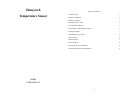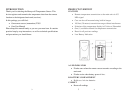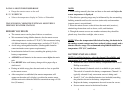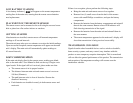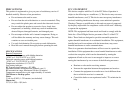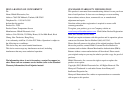
9
9
PRECAUTIONS
This product is engineered to give you years of satisfactory service if
handled carefully. Here are a few precautions:
• Do not immerse the unit in water.
• Do not clean the unit with abrasive or corrosive materials. They
may scratch the plastic parts and corrode the electronic circuits.
• Do not subject the product to excessive force, shock, dust,
temperature, or humidity, which may result in malfunctions,
shorter lifespan, damaged batteries, and damaged parts.
• Do not tamper with the unit’s internal components. Doing so
will invalidate the warranty and may cause damage. This unit
contains no user-serviceable parts.
• Use only fresh batteries. Do not mix new and old batteries.
• Read the user's manual thoroughly before operating the unit.
SPECIFICATIONS
Remote Temperature
Proposed operating range with alkaline batteries:
-20.0°C to + 70.0°C/-4.0°F to + 158°F
Proposed operating range with lithium batteries:
-38.8°C to + 70.0°C/-38.0°F to +158°F
Temperature resolution: 0.1°C/0.2°F
Low battery indicator
RF Transmission Frequency: 433 MHz
Maximum number of transmission channels: one (1)
RF transmission range: Maximum 100 feet (30 meters)
Temperature transmission cycle: approximately 45 seconds
Wall Mount or Desktop option
Power
2 AA size (UM-3) 1.5V batteries (not included)
Dimensions
2.37(L) x 4(H) x 1(D) inch
10
FCC STATEMENT
This device complies with Part 15 of the FCC Rules. Operation is
subject to the following two conditions: (1) This device may not cause
harmful interference, and (2) This device must accept any interference
received, including interference that may cause undesired operation.
Warning: Changes or modification to this unit not expressly approved
by the party responsible for compliance could void the user’s authority
to operate the equipment.
NOTE: This equipment had been tested and found to comply with the
limits for a Class B Digital device, pursuant to Part 15 of the FCC
Rules. These limits are designed to provide reasonable protection
against harmful interference in a residential installation. This equipment,
installed and used in accordance with the instructions, may cause
harmful interference to radio communications.
There is no guarantee that interference will not occur in a particular
installation. If this equipment does cause harmful interference to radio
or television reception, which can be determined by turning the
equipment off and on, the user is encouraged to improve or correct
turning the interference by one or more of the following measures:
• Reorient or relocate the receiving antenna
• Increase the separation between the equipment and receiver.
• Connect the equipment to an outlet on a circuit different from
that to which the receiver is connected.
• Consult the dealer or an experienced radio / TV technician for
help.



